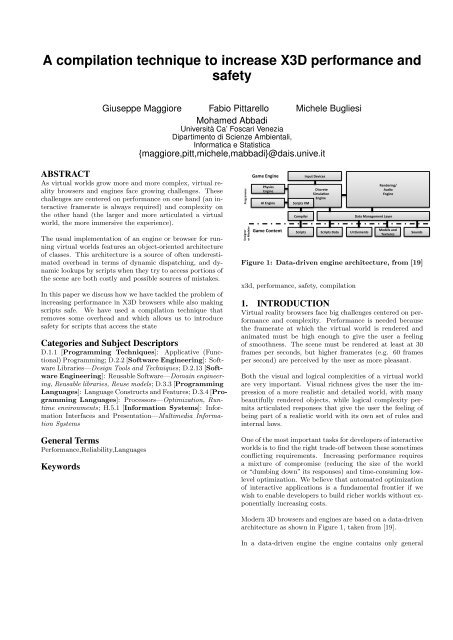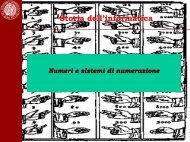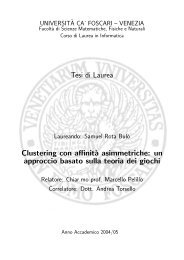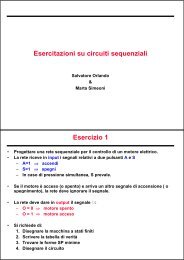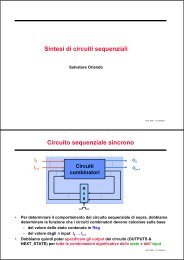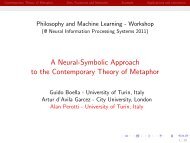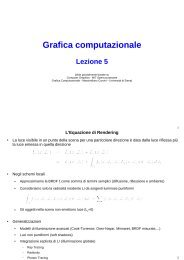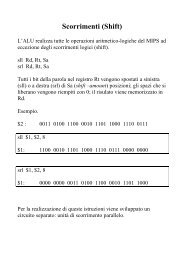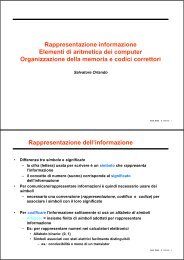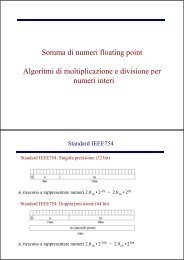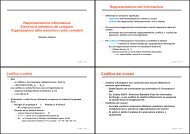A compilation technique to increase X3D performance and safety
A compilation technique to increase X3D performance and safety
A compilation technique to increase X3D performance and safety
You also want an ePaper? Increase the reach of your titles
YUMPU automatically turns print PDFs into web optimized ePapers that Google loves.
A <strong>compilation</strong> <strong>technique</strong> <strong>to</strong> <strong>increase</strong> <strong>X3D</strong> <strong>performance</strong> <strong>and</strong><br />
<strong>safety</strong><br />
Giuseppe Maggiore Fabio Pittarello Michele Bugliesi<br />
Mohamed Abbadi<br />
Università Ca’ Foscari Venezia<br />
Dipartimen<strong>to</strong> di Scienze Ambientali,<br />
Informatica e Statistica<br />
{maggiore,pitt,michele,mabbadi}@dais.unive.it<br />
ABSTRACT<br />
As virtual worlds grow more <strong>and</strong> more complex, virtual reality<br />
browsers <strong>and</strong> engines face growing challenges. These<br />
challenges are centered on <strong>performance</strong> on one h<strong>and</strong> (an interactive<br />
framerate is always required) <strong>and</strong> complexity on<br />
the other h<strong>and</strong> (the larger <strong>and</strong> more articulated a virtual<br />
world, the more immersive the experience).<br />
The usual implementation of an engine or browser for running<br />
virtual worlds features an object-oriented architecture<br />
of classes. This architecture is a source of often underestimated<br />
overhead in terms of dynamic dispatching, <strong>and</strong> dynamic<br />
lookups by scripts when they try <strong>to</strong> access portions of<br />
the scene are both costly <strong>and</strong> possible sources of mistakes.<br />
In this paper we discuss how we have tackled the problem of<br />
increasing <strong>performance</strong> in <strong>X3D</strong> browsers while also making<br />
scripts safe. We have used a <strong>compilation</strong> <strong>technique</strong> that<br />
removes some overhead <strong>and</strong> which allows us <strong>to</strong> introduce<br />
<strong>safety</strong> for scripts that access the state<br />
Categories <strong>and</strong> Subject Descrip<strong>to</strong>rs<br />
D.1.1 [Programming Techniques]: Applicative (Functional)<br />
Programming; D.2.2 [Software Engineering]: Software<br />
Libraries—Design Tools <strong>and</strong> Techniques; D.2.13 [Software<br />
Engineering]: Reusable Software—Domain engineering,<br />
Reusable libraries, Reuse models; D.3.3 [Programming<br />
Languages]: Language Constructs <strong>and</strong> Features; D.3.4 [Programming<br />
Languages]: Processors—Optimization, Runtime<br />
environments; H.5.1 [Information Systems]: Information<br />
Interfaces <strong>and</strong> Presentation—Multimedia Information<br />
Systems<br />
General Terms<br />
Performance,Reliability,Languages<br />
Keywords<br />
Programmer<br />
Designer<br />
or Modeler<br />
Game Engine<br />
Physics<br />
Engine<br />
AI Engine<br />
Scripts VM<br />
Input Devices<br />
Discrete<br />
Simula8on<br />
Engine<br />
Rendering/<br />
Audio<br />
Engine<br />
Compiler Data Management Layer<br />
Game Content Scripts Scripts Data UI Elements<br />
Models <strong>and</strong><br />
Textures<br />
Sounds<br />
Figure 1: Data-driven engine architecture, from [19]<br />
x3d, <strong>performance</strong>, <strong>safety</strong>, <strong>compilation</strong><br />
1. INTRODUCTION<br />
Virtual reality browsers face big challenges centered on <strong>performance</strong><br />
<strong>and</strong> complexity. Performance is needed because<br />
the framerate at which the virtual world is rendered <strong>and</strong><br />
animated must be high enough <strong>to</strong> give the user a feeling<br />
of smoothness. The scene must be rendered at least at 30<br />
frames per seconds, but higher framerates (e.g. 60 frames<br />
per second) are perceived by the user as more pleasant.<br />
Both the visual <strong>and</strong> logical complexities of a virtual world<br />
are very important. Visual richness gives the user the impression<br />
of a more realistic <strong>and</strong> detailed world, with many<br />
beautifully rendered objects, while logical complexity permits<br />
articulated responses that give the user the feeling of<br />
being part of a realistic world with its own set of rules <strong>and</strong><br />
internal laws.<br />
One of the most important tasks for developers of interactive<br />
worlds is <strong>to</strong> find the right trade-off between these sometimes<br />
conflicting requirements. Increasing <strong>performance</strong> requires<br />
a mixture of compromise (reducing the size of the world<br />
or “dumbing down” its responses) <strong>and</strong> time-consuming lowlevel<br />
optimization. We believe that au<strong>to</strong>mated optimization<br />
of interactive applications is a fundamental frontier if we<br />
wish <strong>to</strong> enable developers <strong>to</strong> build richer worlds without exponentially<br />
increasing costs.<br />
Modern 3D browsers <strong>and</strong> engines are based on a data-driven<br />
architecture as shown in Figure 1, taken from [19].<br />
In a data-driven engine the engine contains only general
knowledge about virtual worlds, but nothing specific about<br />
the peculiar features of a specific virtual world. The specific<br />
virtual world will be loaded from the game content in the<br />
form of configuration files <strong>and</strong> scripts. A data-driven engine<br />
loads from files two main datasets:<br />
• a scene, the set of entities that populate the virtual<br />
world<br />
• scripts, the set of (possibly complex) behaviors that<br />
animate the scene entities<br />
The scene is composed by a heterogeneous set of entities,<br />
each of a different kind. Entities may be virtual characters,<br />
trees, 2d or 3d models; entities may also be purely logical<br />
<strong>and</strong> invisible entities such as timers, triggers <strong>and</strong> proximity<br />
sensors.<br />
Scripts give depth <strong>to</strong> a scene by implementing complex interrelationships<br />
between entities. Scripting can be done at<br />
three different levels of increasing complexity <strong>and</strong> expressive<br />
power:<br />
• routing is a simple transmission of values from one<br />
entity <strong>to</strong> another<br />
• more complex scripts can perform data conversions<br />
when moving information between entities<br />
• even more advanced scripts can create, remove or modify<br />
entities of a scene<br />
The usual implementation of an engine (see [6]) features<br />
an object-oriented architecture of classes. At the root of<br />
this architecture is a class that represents the most generic<br />
entity, <strong>and</strong> from which all other entities are derived. The<br />
engine maintains a list of these generic entities, which are<br />
all updated <strong>and</strong> h<strong>and</strong>led through a set of virtual functions.<br />
This architecture is a source of often underestimated overhead.<br />
Dynamic dispatching is not <strong>to</strong>o costly for a few calls,<br />
but when we have many entities, the cost of invoking various<br />
virtual functions many times for each frame can become<br />
very high. Sometimes the cost of the dynamic dispatching<br />
architecture may become higher than the cost of the actual<br />
operations being dispatched.<br />
Scripts usually access the scene dynamically. This means<br />
that a script must look for the right entities with a mixture<br />
of lookups by name <strong>and</strong> unsafe casts. For example, consider<br />
how a Java script may access the time field of a myClock<br />
node of type timer:<br />
\ add<strong>to</strong>length {\ itemsep }{ -0.5\ baselineskip }<br />
<strong>X3D</strong>Node myClock =<br />
mainScene . getNamedNode (" myClock ");<br />
SFTime time =<br />
( SFTime ) myClock . getField (" time ");<br />
This style is unsafe, since myClock may not exist or it may<br />
have the wrong type, <strong>and</strong> it also incurs in significant overhead.<br />
In this paper we will focus exclusively on the <strong>X3D</strong> language,<br />
since it is a recognized st<strong>and</strong>ard <strong>and</strong> it offers a good<br />
Figure 2: Solution workflow<br />
benchmark <strong>to</strong> test virtual worlds where we can specify our<br />
scene <strong>and</strong> its various scripts. In the paper we show how<br />
we have tackled the problem of increasing <strong>performance</strong> in<br />
<strong>X3D</strong> browsers while also making scripts safe. We have used<br />
a simple <strong>compilation</strong> <strong>technique</strong> that removes many unnecessary<br />
dynamically dispatched invocations; this <strong>technique</strong><br />
also allows us <strong>to</strong> introduce <strong>safety</strong> for scripts that access the<br />
state, so that they do not need <strong>to</strong> perform unsafe dynamic<br />
lookups when searching for specific nodes. To the best of<br />
our knowledge, this is the first approach that experiments<br />
with compiling <strong>X3D</strong> scripts <strong>and</strong> scenes in order <strong>to</strong> achieve<br />
greater <strong>performance</strong> <strong>and</strong> safe scripts. None of the previous<br />
approaches we are aware of focuses on <strong>compilation</strong> of<br />
<strong>X3D</strong> as a means <strong>to</strong> achieve both higher <strong>performance</strong> (by<br />
reducing overhead) <strong>and</strong> <strong>safety</strong> (by introducing compile-time<br />
checks). Higher <strong>performance</strong> through <strong>compilation</strong> includes a<br />
long list of research work such as [7, 10, 5] which has shown<br />
that <strong>compilation</strong> can yield better runtime <strong>performance</strong> by<br />
reducing dynamic overhead <strong>and</strong> improving other properties<br />
of the generated code. Similarly, introducing <strong>safety</strong> in dynamic<br />
languages such as scripting systems has been studied<br />
in general in the context of generating typed programs from<br />
untyped scripts in [13], <strong>and</strong> the problem of statically typing<br />
information which is generally untyped has also been<br />
explored in the Haskell community in [18] among many others.<br />
In Section 2 we discuss the general architecture of our system.<br />
In Section 3 we show how our <strong>technique</strong> generates the<br />
code <strong>and</strong> the type definitions that represent a scene. In Section<br />
4 we show an example of a compiled scene <strong>and</strong> its routes.<br />
In Section 5 we report some benchmarks that show speed increasing<br />
when rendering a sample scene with just nodes <strong>and</strong><br />
routes by applying our <strong>technique</strong>. Finally, in Section 6 we<br />
discuss how we represent scripts that externally access the<br />
scene.<br />
2. SOLUTION WORKFLOW<br />
In Figure 2 we can see a diagram depicting the steps used<br />
by our system when processing an <strong>X3D</strong> scene (plus its accompanying<br />
scripts). In the figure red blocks represent data<br />
while the blue blocks represent computations. We start with<br />
an <strong>X3D</strong> file which describes our scene. This file may contain<br />
some scripts as routes, in script node, or the scripts<br />
may be s<strong>to</strong>red in<strong>to</strong> an external file. There are two layers of<br />
transformations described by our system:<br />
• a transformation from the original external scripts in<strong>to</strong><br />
our F# scripts<br />
• a transformation from the original entities <strong>and</strong> routes<br />
of the <strong>X3D</strong> file in<strong>to</strong> the final program
In the current development stage we have implemented part<br />
of the first transformation (we translate those scripts that<br />
are expressed as routes) <strong>and</strong> the second transformation (we<br />
can process any scene entity). The <strong>X3D</strong> scene <strong>and</strong> its routes<br />
are translated in<strong>to</strong> F# source code. This source code contains<br />
a type definition that describes the entire scene <strong>and</strong><br />
the routes, plus an update function that translates the activation<br />
of scripts as a consequence of the changes in the<br />
entities that result from a user action or from the temporal<br />
evolution of the scene. Such conversion therefor supports<br />
the translation of regular <strong>X3D</strong> nodes that describe shapes<br />
<strong>and</strong> the various scene entities, <strong>and</strong> also routing nodes that<br />
describe basic scripts.<br />
Our system supports external scripts, that is any script that<br />
is not expressed as a route, but only if they are provided<br />
already translated <strong>to</strong> F#; this means that our system cannot<br />
translate <strong>and</strong> process scripts written in Javascript <strong>and</strong> Java,<br />
but it can process those scripts if the translation has been<br />
done by h<strong>and</strong>. External scripts in F# are validated against<br />
our type definitions, <strong>to</strong> ensure that they correctly access the<br />
scene. If their validation succeeeds, the final program is<br />
produced that integrates both the scene <strong>and</strong> all the scripts.<br />
This second processing gives our system support for any<br />
other scripts which are not easily expressed with routes.<br />
We have used F# [9, 12], a multi-paradigm functional programming<br />
language targeting the .NET Framework. It is<br />
a variant of ML <strong>and</strong> is largely compatible with the OCaml<br />
implementation. F# enjoys full support in the .NET Framework,<br />
meaning that it can take advantage of all .Net libraries<br />
(such as XNA for game development, which is most useful<br />
<strong>to</strong> us) <strong>and</strong> powerful IDEs such as Visual Studio <strong>and</strong> MonoDevelop.<br />
3. COMPILING THE SCENE<br />
In this section we show an outline of our <strong>compilation</strong> <strong>technique</strong>.<br />
The first step our compiler performs is deserializing the xml<br />
definition of our <strong>X3D</strong> scene. The scene is then processed<br />
<strong>and</strong> turned in<strong>to</strong> a record, a type definition that describeds<br />
the static structure of our scene. The record contains:<br />
• a field for each static node of the scene; each field has<br />
the name of the node if the node has a DEF attribute<br />
• a field for a list of dynamic nodes<br />
• a field for a list of active scripts<br />
A sample state for a scene with a timer <strong>and</strong> a box could be:<br />
type Scene =<br />
{<br />
myClock : Timer<br />
box : Box<br />
dynamic_nodes : List <br />
script : Script<br />
}<br />
Where Timer <strong>and</strong> Box are the concrete classes for a timer<br />
<strong>and</strong> a box respectively, <strong>and</strong> they both inherit from the Node<br />
class. A list of nodes is needed <strong>to</strong> represent the dynamic<br />
portions of the scene, <strong>and</strong> a list of scripts maintains the<br />
sequence of currently running scripts.<br />
This state definition is quite important, since it represents<br />
the interface between our scene <strong>and</strong> our scripts, <strong>and</strong> since it<br />
allows us fast lookups of specific nodes. Finding a node now<br />
just requires reading from a field in the state, an operation<br />
which is both fast <strong>and</strong> certain not <strong>to</strong> fail. For example, looking<br />
for the time field of the "myClock" node would simply<br />
require writing:<br />
scene . myClock . time<br />
We then proceed <strong>to</strong> the initialization of the state. This<br />
amounts <strong>to</strong> creating instances of each node, <strong>and</strong> then assigning<br />
these instances <strong>to</strong> the fields of the scene variable.<br />
An update function is then constructed that performs the<br />
update of all the statically known fields of the state, <strong>and</strong><br />
which also executes the various routes of the scene. Also,<br />
the update function invokes the (dynamically dispatched)<br />
update function of each dynamic node; this is necessary because<br />
it would be unrealistic <strong>to</strong> hope that a complex virtual<br />
world can exclusively rely on statically known nodes, <strong>and</strong> a<br />
balance must be struck between optimizing static nodes <strong>and</strong><br />
supporting dynamic ones.<br />
The update function also performs a tick for all currently<br />
running scripts.<br />
The update function that updates the state seen above would<br />
simply become:<br />
let update (dt: float32 ) =<br />
scene . myClock . update dt<br />
scene . box . update dt<br />
for node in scene . dynamic_nodes do<br />
node . update dt<br />
scene . script . update dt<br />
We could add a simple route that moves the box node along<br />
the Y-axis according <strong>to</strong> the current time of the myClock node<br />
by adding the following line of code <strong>to</strong> the update function:<br />
scene . box . Position .Y <br />
< TimeSensor DEF =’myClock ’ cycleInterval =’10.0 ’ loop<br />
=’true ’/><br />
<br />
<br />
< Appearance >
Material DEF =’myMaterial ’/><br />
<br />
<br />
<br />
<br />
<br />
Our compiler produces the following state definition from<br />
the above scene:<br />
type Scene =<br />
{<br />
myColor : ColorInterpola<strong>to</strong>r<br />
myClock : TimeSensor<br />
myMaterial : Material<br />
dynamic_nodes : List <br />
script : Script<br />
}<br />
where pointers <strong>to</strong> all statically known nodes are maintained.<br />
The initialization function for our state initializes a set of<br />
local variables, one for each named node, <strong>and</strong> then builds<br />
the actual scene state. Notice that at this point routes are<br />
ignored, since they will be used only for the update function:<br />
let scene =<br />
let myColor =<br />
ColorInterpola<strong>to</strong>r (<br />
keyValue = [ ... ],<br />
key = [ ... ])<br />
let myClock =<br />
TimeSensor (<br />
cycleInterval = 10.0 ,<br />
loop = true )<br />
let myMaterial = Material ()<br />
let dynamic_nodes =<br />
[<br />
Shape (<br />
Value =<br />
Box ( Appearance ( Value = myMaterial )))<br />
]<br />
{<br />
myColor = myColor<br />
myClock = myClock<br />
myMaterial = myMaterial<br />
dynamic_nodes = dynamic_nodes<br />
script = null<br />
}<br />
After initializing the scene without a script, we can load the<br />
script from an external parameter that will be assigned in<br />
the linking phase. Loading a script requires passing <strong>to</strong> it the<br />
scene, so that the script may access the scene <strong>to</strong> manipulate<br />
it:<br />
scene . script := load_script scene<br />
The update function invokes the internal update function<br />
of all nodes, starting from the statically known <strong>and</strong> ending<br />
with the dynamic ones. Routes are executed in the update<br />
function:<br />
let update dt =<br />
scene . myClock . update dt<br />
scene . myColor . update dt<br />
scene . myMaterial . update dt<br />
for node in scene . dynamic_nodes do<br />
node . update dt<br />
scene . script . update dt<br />
myColor . fraction
Browser FPS FPS (with routes) Diff %<br />
Test machine 1<br />
Ours (300 shapes) 580 510 -12<br />
Ours (680 shapes) 265 224 -15<br />
Octaga (300 shapes) 670 340 -49<br />
Octaga (680 shapes) 372 150 -60<br />
BS C. (300 shapes) 370 300 -19<br />
BS C. (680 shapes) 185 145 -22<br />
Test machine 2<br />
Ours (300 shapes) 670 590 -12<br />
Ours (680 shapes) 310 265 -15<br />
BS C. (300 shapes) 530 368 -31<br />
BS C. (680 shapes) 285 146 -49<br />
Test machine 3<br />
Ours (300 shapes) 640 600 -6<br />
Ours (680 shapes) 310 280 -10<br />
Octaga (300 shapes) 720 403 -44<br />
Octaga (680 shapes) 345 181 -48<br />
BS C. (300 shapes) 500 360 -28<br />
BS C. (680 shapes) 215 135 -37<br />
Table 1: Test results<br />
Figure 3: WP7 Emula<strong>to</strong>r, BS Contact <strong>and</strong> XNA<br />
Windows Application<br />
droid, but in our case having used XNA a porting <strong>to</strong> Windows<br />
Phone 7 required literally no effort beyond modifying<br />
a compiler switch.<br />
Scene FPS<br />
150 shapes with routes 30<br />
300 shapes with routes 24<br />
Table 2: WP7 (LG Optimus 7)<br />
At this point we have completed supporting the static aspects<br />
of an <strong>X3D</strong> scene, those that are involved in nodes<br />
that are not added or removed dynamically. This approach<br />
clearly yields an <strong>increase</strong> in <strong>performance</strong> for scenes with a<br />
complex logic in terms of timers, routes, interpola<strong>to</strong>rs, etc.<br />
6. EXTERNAL SCRIPTS<br />
Scripting is a very important part of game development [20].<br />
For this reason we have adapted <strong>to</strong> our system a scripting<br />
solution that is derived from game engines. Whereas many<br />
game engines either use Lua, Python or even C# as scripting<br />
languages (with various advantages <strong>and</strong> disadvantages)<br />
[1, 3, 2] we have used F# which we believe offers a powerful<br />
mix of the best features of all these languages: coroutines,<br />
flexibility <strong>and</strong> a lightweight syntax make F# scripts similar<br />
<strong>to</strong> LUA <strong>and</strong> Python while static typing <strong>and</strong> support for<br />
.Net libraries <strong>and</strong> IDEs put F# on par with C# in terms of<br />
broader support.<br />
To give additional expressive power <strong>to</strong> our scene, we add<br />
support <strong>to</strong> external scripts; external scripts are all those<br />
scripts that cannot be expressed in terms of routes. External<br />
scripts are very general, that is they can perform complex<br />
data conversions when copying values across entities, <strong>and</strong><br />
they may even create, remove <strong>and</strong> modify nodes in any way<br />
possible. To represent external scripts, rather than using<br />
arbitrary objects that can access the state we have chosen<br />
<strong>to</strong> use coroutines, a widely used mechanism for representing<br />
computations in interactive applications [14, 4]. Coroutines<br />
are subroutines that can be suspended <strong>and</strong> resumed at certain<br />
locations. With coroutines the code for a SM is written<br />
“linearly” one statement after another, but each action may<br />
suspend itself (an operation often called “yield”) many times<br />
before completing. A coroutine s<strong>to</strong>res a temporary, internal<br />
state transparently inside its continuation.<br />
We build a monadic framework [15, 16, 17, 11] for coroutines<br />
that allows us greater cus<strong>to</strong>mization flexibility. This way<br />
we can define our own system for combining scripts running<br />
them in parallel, concurrently, etc. For a detailed discussion<br />
of this monadic framework for scripts <strong>and</strong> coroutines see [8].<br />
A script in our system is defined as a normal F# program<br />
surrounded by { } brackets. A script runs another script<br />
with the statements let! <strong>and</strong> do!, <strong>and</strong> scripts can be combined<br />
with a small set of opera<strong>to</strong>rs.<br />
The main opera<strong>to</strong>rs <strong>to</strong> combine scripts are:<br />
• parallel (s1 ∧ s2) executes two scripts in parallel <strong>and</strong><br />
returns both results<br />
• concurrent (s1 ∨ s2) executes two scripts concurrently<br />
<strong>and</strong> returns the result of the first <strong>to</strong> terminate<br />
• guard (s1 ⇒ s2) executes <strong>and</strong> returns the result of a<br />
script only when another script evaluates <strong>to</strong> true<br />
• repeat (↑ s) keeps executing a script over <strong>and</strong> over<br />
A sample script that moves the box myBox when the user<br />
enters a certain region myRegion could be the following:<br />
let my_script ( scene : Scene ) =<br />
let rec animate =<br />
script {<br />
if scene . myBox . Position .Y < 100.0 f then<br />
scene . myBox . Position .Y
this script is applied <strong>to</strong> does not have a Box node with name<br />
myBox) we will get a compile-time error. This makes it easier<br />
<strong>to</strong> build larger, reusable script modules since a mistake in<br />
using a pre-made module is easier <strong>to</strong> spot <strong>and</strong> requires less<br />
testing. Using scripts which have been made for different<br />
scenes would require extensive testing <strong>to</strong> ensure at least that<br />
all node accesses are correct.<br />
Our scripting system is expressive enough <strong>to</strong> represent many<br />
scripts running <strong>to</strong>gether, even if at a first glance it may<br />
appear that our system supports only a single script. By<br />
using the parallel opera<strong>to</strong>r we can combine <strong>to</strong>gether a large<br />
number of scripts. For example, let us say we have many<br />
scripts s1, ..., sn that must all run <strong>to</strong>gether with our scene.<br />
Each scripts has a different duration, that is the not all<br />
scripts will end at the same time (indeed, a script may even<br />
run indefinitely). The main script would chain each of the<br />
various actual scripts in the following manner:<br />
let my_script ( scene : Scene ) =<br />
parallel s1 ( parallel s2 ... sn) ... )<br />
7. CONCLUSIONS AND FUTURE WORK<br />
In this paper we have presented a novel approach <strong>to</strong> optimizing<br />
<strong>X3D</strong> scenes. Upon recognition that <strong>X3D</strong> requires the<br />
highest possible degree of <strong>performance</strong> <strong>and</strong> <strong>safety</strong> we have<br />
experimented with a move from the slower, dynamic interpretation<br />
that current <strong>X3D</strong> browsers do <strong>to</strong> a faster, static<br />
compiled model of execution which creates a “specialized<br />
browser” for every <strong>X3D</strong> scene.<br />
Thanks <strong>to</strong> type <strong>safety</strong> we are sure that the compiled result<br />
is valid (routes are correct, etc.) <strong>and</strong> that external scripts<br />
correctly access the scene nodes; any error will be detected<br />
at compile time, thus reducing the amount of testing needed<br />
<strong>and</strong> of errors ending up in the final release.<br />
Thanks <strong>to</strong> our system it has been possible <strong>to</strong> run our compiled<br />
<strong>X3D</strong> scenes with different platforms that support XNA.<br />
In particular we have tested our benchmark scenes on the<br />
Xbox 360 <strong>and</strong> Windows Phone 7. While the Xbox is very<br />
similar <strong>to</strong> a PC in terms of hardware, the ability of running<br />
<strong>X3D</strong> scenes on powerful mobile devices is extremely interesting<br />
since it unlocks new interaction opportunities; moreover,<br />
optimizations such as ours become crucial <strong>to</strong> make good use<br />
of the limited computing power of such devices.<br />
Our work is by no means complete. We still need <strong>to</strong> implement<br />
some of the primitives of our target <strong>X3D</strong> profile<br />
(the Interactive profile). We would like <strong>to</strong> experiment with<br />
au<strong>to</strong>mated <strong>compilation</strong> of Javascript <strong>and</strong> Java scripts, <strong>to</strong> <strong>increase</strong><br />
our support of <strong>X3D</strong> in this direction as well. Also,<br />
we wish <strong>to</strong> study if there are other possible classes of optimizations<br />
that can be performed during our code generation<br />
phase. Finally, we wish <strong>to</strong> study what kind of optimizations<br />
are needed <strong>to</strong> ensure fast <strong>and</strong> high-quality execution of interactive<br />
virtual worlds on mobile devices.<br />
References<br />
[1] Games using lua as a scripting language.<br />
http://en.wikipedia.org/wiki/Category:Luascripted<br />
video games.<br />
[2] Scripting in unity. http://unity3d.com/support/<br />
documentation/ScriptReference/index.Coroutines<br />
26 Yield.html.<br />
[3] Bruce Dawson. Game scripting in python. http://<br />
www.gamasutra.com/features/ 20020821/dawson<br />
pfv.htm, 2002. Game Developers Conference Proceedings.<br />
[4] L. H. de Figueiredo, W. Celes, <strong>and</strong> R. Ierusalimschy.<br />
Programming advanced control mechanisms with lua<br />
coroutines. In Game Programming Gems 6, pages 357–<br />
369, 2006.<br />
[5] Jeffrey Dean, David Grove, <strong>and</strong> Craig Chambers. Optimization<br />
of object-oriented programs using static<br />
class hierarchy analysis. In ECOOP¡ S95 Â˚ U Object-<br />
Oriented Programming, 9th European Conference, Denmark,<br />
August 7ÂŰ11, 1995, Lecture Notes in Computer<br />
Science. Springer Berlin / Heidelberg.<br />
[6] Julian Gold. Object-Oriented Game Development.<br />
Pearson Addison Wesley, 2004.<br />
[7] T. Kisuki, P.M.W. Knijnenburg, M.F.P. Oapos;Boyle,<br />
<strong>and</strong> H. A. G. Wijshoff. Iterative <strong>compilation</strong> in program<br />
optimization, 2000.<br />
[8] G. Maggiore, F. Pittarello, <strong>and</strong> M. Bugliesi. Compiling<br />
x3d for <strong>increase</strong>d <strong>performance</strong> <strong>and</strong> <strong>safety</strong>. Technical<br />
Report 2011-6, Ca’ Foscari - DAIS, 2011.<br />
[9] Giuseppe Maggiore <strong>and</strong> Giulia Costantini. Friendly F#<br />
(fun with game programming). Smashwords.<br />
[10] H. Masuhara, G. Kiczales, <strong>and</strong> C. Dutchyn. A <strong>compilation</strong><br />
<strong>and</strong> optimization model for aspect-oriented programs.<br />
In Compiler Construction, volume 2622 of Lecture<br />
Notes in Computer Science, pages 46–60. Springer<br />
Berlin / Heidelberg, 2003.<br />
[11] Eugenio Moggi. Notions of computation <strong>and</strong> monads.<br />
Information <strong>and</strong> Computation, 93:55–92, 1989.<br />
[12] Don Syme. F# - microsoft research.http://research.microsoft.com/enus/um/cambridge/projects/fsharp/.<br />
[13] Sam Tobin-Hochstadt <strong>and</strong> Matthias Felleisen. Interlanguage<br />
migration: from scripts <strong>to</strong> programs. In Companion<br />
<strong>to</strong> the 21st ACM SIGPLAN symposium on Objec<strong>to</strong>riented<br />
programming systems, languages, <strong>and</strong> applications,<br />
OOPSLA ’06. ACM.<br />
[14] Guido Van Rossum <strong>and</strong> Phillip Eby J. Pep<br />
342 - coroutines via enhanced genera<strong>to</strong>rs.<br />
http://www.python.org/dev/peps/pep-0342/, 2010.<br />
[15] Philip Wadler. Comprehending monads. In Mathematical<br />
Structures in Computer Science, pages 61–78, 1992.<br />
[16] Philip Wadler. How <strong>to</strong> declare an imperative. ACM<br />
Comput. Surv., 29(3):240–263, 1997.<br />
[17] Philip Wadler <strong>and</strong> Peter Thiemann. The marriage of<br />
effects <strong>and</strong> monads, 1998.<br />
[18] Malcolm Wallace <strong>and</strong> Colin Runciman. Haskell <strong>and</strong><br />
xml: generic combina<strong>to</strong>rs or type-based translation?<br />
SIGPLAN Not., 1999.<br />
[19] Walker White, Alan Demers, Chris<strong>to</strong>ph Koch, Johannes<br />
Gehrke, <strong>and</strong> Rajmohan Rajagopalan. Scaling<br />
games <strong>to</strong> epic proportions. In Proceedings of the 2007<br />
ACM SIGMOD international conference on Management<br />
of data, SIGMOD ’07, pages 31–42, New York,<br />
NY, USA, 2007. ACM.<br />
[20] Walker White, Chris<strong>to</strong>ph Koch, Johannes Gehrke, <strong>and</strong><br />
Alan Demers. Better scripts, better games. Queue,<br />
6:18–25, November 2008.


